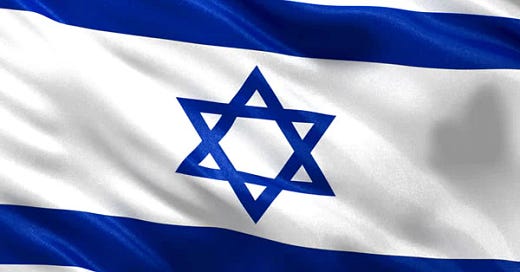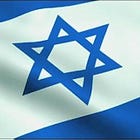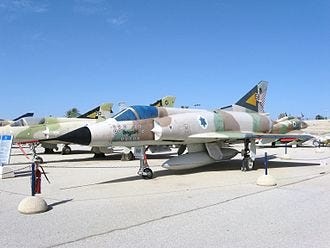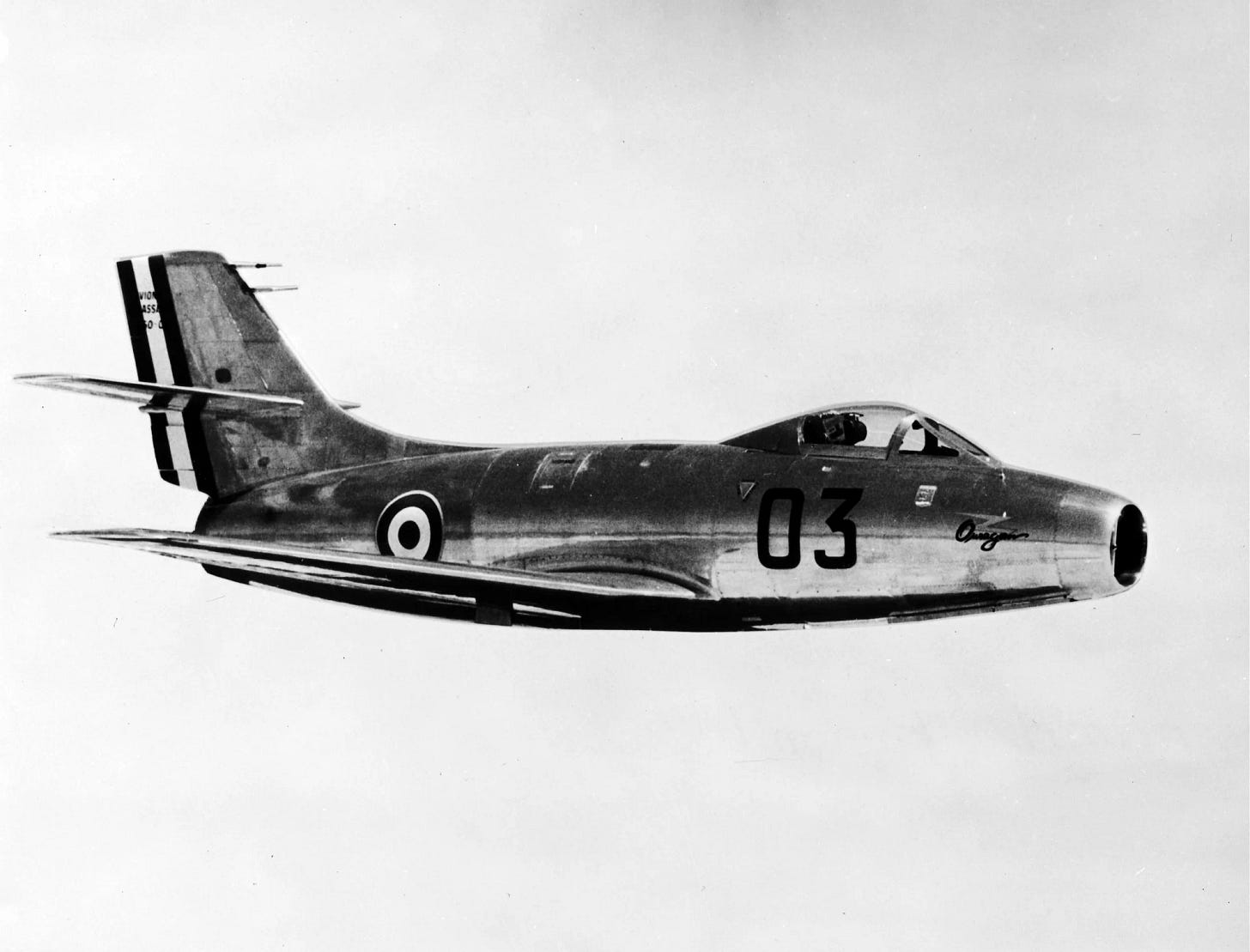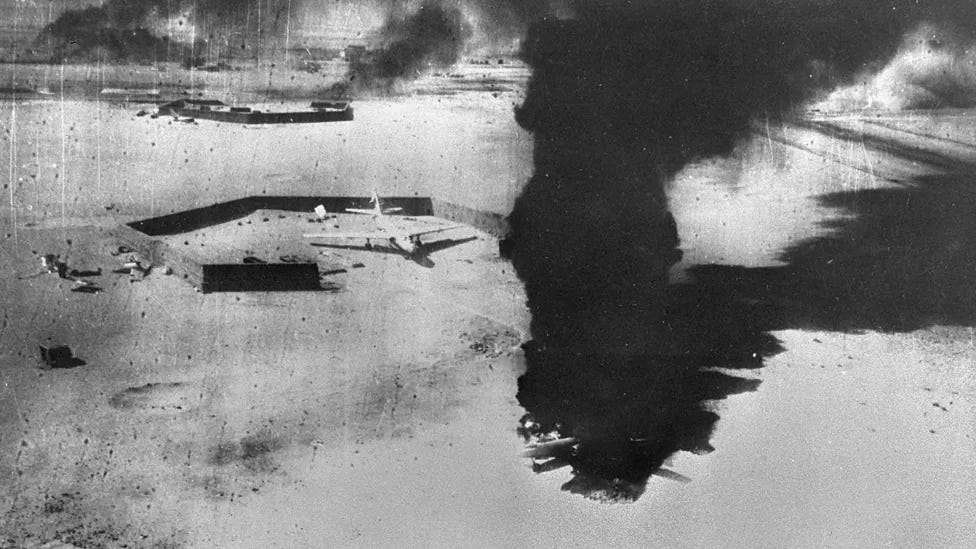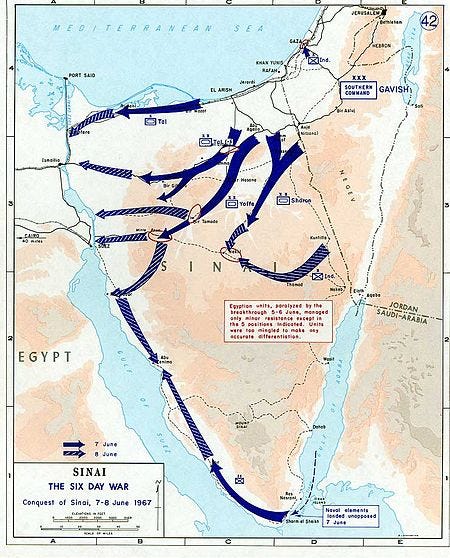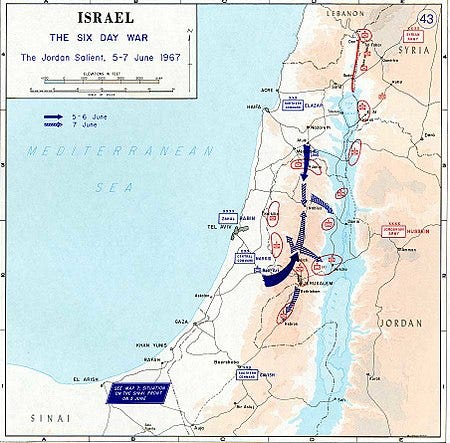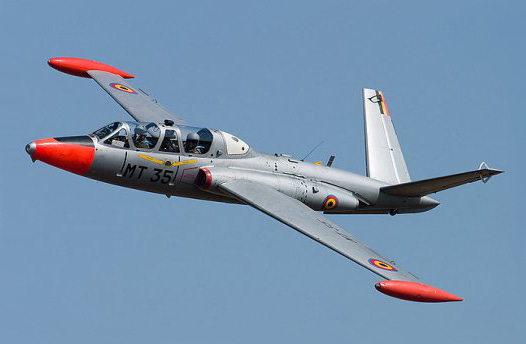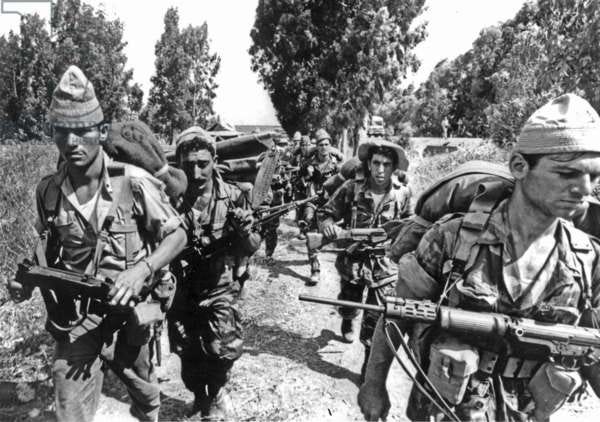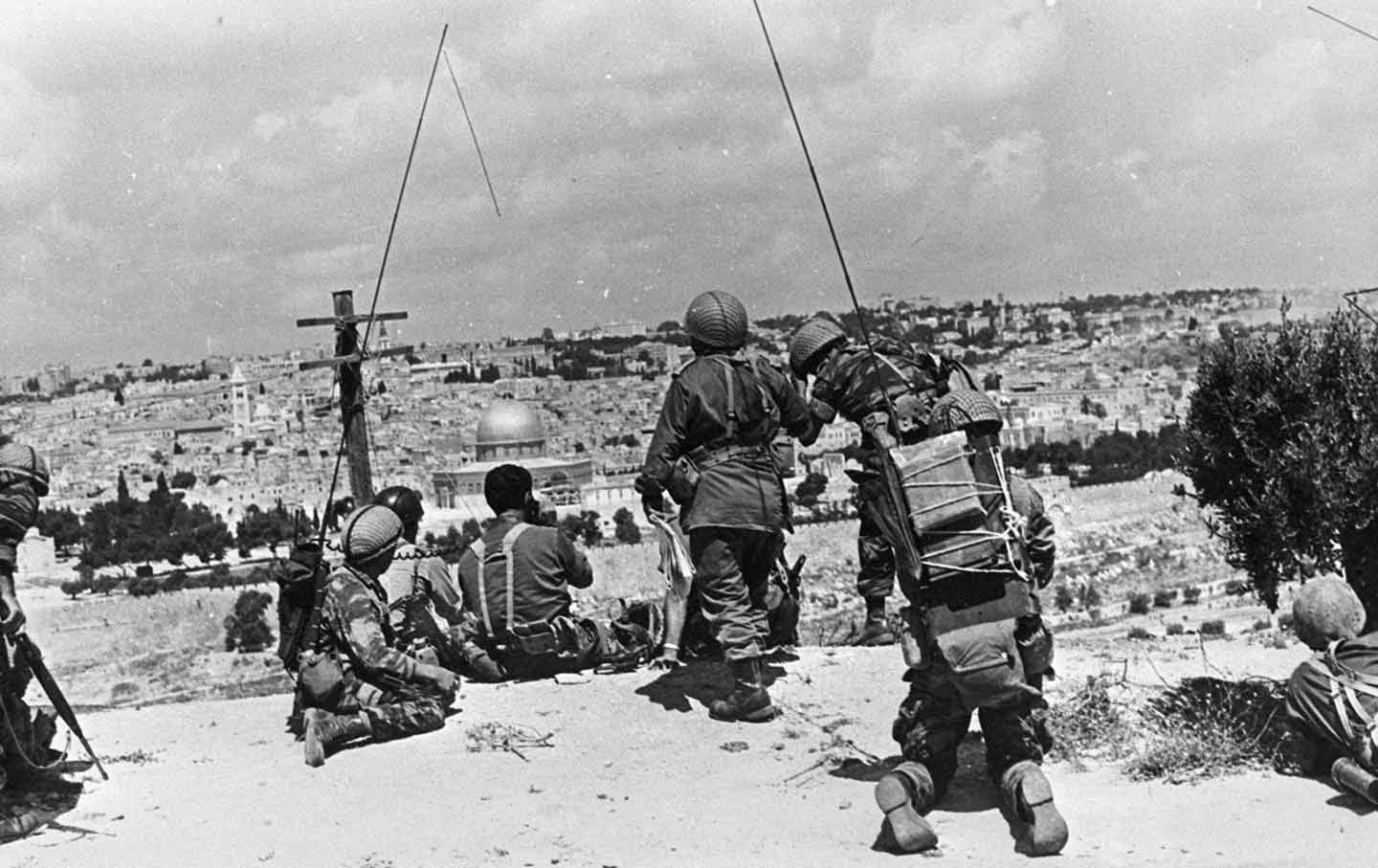In my last post I wrote about the history and events leading up to the Six Day War. Click below if you missed it.
Today I will talk about that war, one of the most lopsided victories in the history of military conflicts.
Long before the events of early 1967, Israeli military planners were considering, that any future war Israel would be involved in would be at least a two front war, and very likely a three front war. Now, Israel is a narrow country, only six miles wide in it's middle. Israeli commanders can not trade space for time like the Russians or even the French could. They had to think of other ways to fight a war. The military knew that the best way to fight this future war would be as an offensive operation, not waiting to be attacked but fight the battle on your terms and on ground of your choosing. The Israelis had been working on a plan for some time and the plan they came up with was called Focus. It was a plan to destroy the air force of Egypt, allowing the Israeli army to quickly overwhelm Egyptian ground forces and then turn their full attention to Jordan and Syria in turn. The Israeli Air Force (IAF) had trained their ground crews and pilots to the point where they could rearm and refuel a returning jet fighters in eight minutes, meaning that for targets that were 45 minutes flying time away, they could launch an attack wave every fifteen minutes, with a time over target (TOT) time of fifteen minutes. That would mean that when the first wave was done with their attack and turning for home, the second wave is just arriving over the target and the third wave is halfway there and with an eight minute turnaround time, the Israelis could keep planes over the targets as long as they needed to. The IAF also had a new weapon, an anti-runway weapon jointly developed by the Israelis and the French. The bomb, called the Matra Durandal, a single 450 lb. bomb with parachute braking, rocket booster, and two warheads is dropped by an aircraft flying at low level, it is braked by the parachute, and when at the correct angle fires the rocket to send it deep into the runway, were the first large explosive charge explodes to create a crater, then a second, smaller charge, deep inside the crater explodes to displace adjacent concrete slabs. The slabs, once displaced, are far harder to deal with than a simple hole that can be repaired by plowing the debris back into it and then patching it with asphalt. Once the runways were disabled, the entire air bases' complement of aircraft were effectively grounded and could be destroyed where they sat. Once air superiority was achieved then the IAF would be released to conduct air support missions around the region.
On June 4 1967 after the Israeli cabinet voted for a preemptive strike against Egypt, Secretary of Defense Moshe Dayan informed IDF Chief of Staff Lieutenant General Yitzhak Rabin and Air Force Commander Major General Mordechai "Mottie" Hod, to launch Operation Moked (Focus) the next day.
At 7:00 am on June 5, the IAF launched all but 12 of its 200 operational jets, including training planes retro-fitted for combat. The majority of the jets flew far out into the Mediterranean in order to strike their Egyptian targets from an unexpected direction. The rest flew into the Sinai Desert to attack airfields there. All the planes flew low (50 feet above the surface) to avoid detection by radar. However, they were detected by Jordanian radar as they left their bases. Jordan passed on the information about the sortie to the Egyptians but it was sent encoded and Egypt had just changed their codes, the day before, and were not able to decode it in a timely manner. They were also nearly detected by a Antonov An-12 Cub carrying senior Egyptian commanders, including Commander in Chief Field Marshall Amer, commander of the 3rd Infantry Division General Anwar al-Qadi and Commander in Chief of the Egyptian Air Force General Mohamed Sedky Mahmoud, en route to Bir al-Thamada to inspect the troops stationed in the Sinai. After flying 100 miles west, the Israeli planes turned south and split up, heading for one of the eleven airfields marked for attack. They came in low skimming the dunes and only popped up to their 6,000 foot attack height just before reaching the airfields. The flights headed for Sinai had a more direct route but followed the same plan, skimming low until very close to the airfields and then popping up to make their attacks.
The surprise was total, as the Israeli pilots popped up, even they were astonished by what they saw. Row after row of neatly park Egyptian bombers and fighters. The first few planes dropped the Matra Durandals putting huge holes in every runway at every airfield, trapping all those pretty planes like literal sitting ducks. The few planes that got in the air before the runways were destroyed were quickly shot down. In three main waves of attacks, the IAF destroyed 338 Egyptian aircraft, leaving Israel in control over the skies of Egypt and the Sinai. As soon as Amer and the passengers on the An-12 were notified of the attack the plane turned around to return to Egypt but had to fly all the way to Cairo because all the military airfields in the area had been destroyed. In fact they could not even get military transportation to their headquarters and had to take taxis instead.
Operation Focus was an overwhelming success: Egypt's air force was destroyed in the space of three hours, with only minor losses to the IAF. When Syria, Jordan and Iraq attacked Israeli civilian targets, Israel turned their attention from Egypt to the other countries. Destroying 69 Syrian, 29 Jordanian and 23 Iraqi aircraft. By the end of the first day of the war, Israel had complete air superiority over Egypt, Syria, Jordan and the entire Sinai desert.
In the army headquarters in Cairo, the commanders were increasingly gripped by panic. General Salahdeen Hadidi slumped in his chair, convinced that the war was at least half lost, but in reality it was even worse than that for Egypt. However, outside on the streets the people were celebrating. Crowds poured into the city by evening on buses provided by the ruling party. Voice of the Arabs Radio was their trusted source of news, and it was pushing out fantasy. By 8:30 pm it was reporting that 86 Israeli aircraft had been destroyed and that Egyptian tanks had broken into Israel. At the headquarters of the Sinai front, General Mohamed Abdel Ghani Gamasy listened "with growing horror" to what he knew was a pack of nonsense. Years later the chief announcer, Ahmed Said, was asked why he went on the air with such outrageous lies. He said "You're asking people to fight, not dance… we believed the broadcasts were our most powerful weapon… many of our listeners were illiterate, so radio was the most important way to reach them." As real news of the defeats came through, Nasser and Amer had retreated to their villas and Anwar Sadat, who later as president, went for a long walk through the streets of Cairo. "Dazed and broken-hearted" he watched Nasser loyalists marching up and down the main avenue leading to the pyramids, chanting and dancing to fake reports of an imaginary victory.
On the ground the Israelis were just as outnumbered as in the air. The Egyptian forces consisted of seven divisions; four armored, one mechanized infantry and two infantry, with 100,000 troops, 950 tanks, 1,100 armored personnel carriers and 1,000 artillery pieces. This arrangement was based on Soviet doctrine, where mobile armor units provided an overwhelming offensive punch, while infantry units followed behind to mop up. In a defensive situation, the plan was for the armor to move around the battlefield to wherever it was needed most, as the infantry fought static defensive battles.
Israeli forces concentrated on the border with Egypt included six armored brigades, three paratrooper brigades, one mechanized infantry brigade and one infantry brigade. Organized into three divisions with 70,000 men and 700 tanks. They had massed on the border the night of June 4, camouflaging themselves and observing radio silence. The Israeli plan was to surprise the Egyptian forces in both in the timing of the attack, (coinciding with the IAF strike on Egyptian airfields), the route of advance, (attacking via northern and central Sinai routes, as opposed to the Egyptian expectations of central and southern routes) and the method (using a combined-force flanking approach, rather than direct tank assaults).
On June 5, at 7:50 am, as Israeli planes were attacking Egyptian airfields, the 84th Armored Division commanded by Major General Israel Tal, crossed the border at two points, opposite Nahal Oz and south of Khan Yunis. They advanced swiftly, holding fire to prolong the element of surprise. Tal's forces assaulted the "Rafah Gap", a seven mile stretch containing the shortest of three main routes through the Sinai towards El Qantara and the Suez Canal. The Egyptians had four heavily dug in divisions backed by minefields in the area and the terrain on either side of the route was impassable. The Israeli plan was to hit the Egyptians at selected key points with a concentrated armor assault. Tal's advance was led by the 7th Armored Brigade under Colonel Shmuel Gonen. The Israeli plan called for the 7th Brigade to outflank Khan Yunis from the north and the 60th Armored Brigade under Colonel Menachem Aviram from the south. The two brigades would link up and surround Khan Yunis, while Colonel Rafael Eitan and his 202nd Paratrooper Brigade would take Rafah (an Egyptian city, not the Gaza Strip city of the same name.). Colonel Gonen tasked a single battalion from his brigade to make the breakthrough. Initially, the advance was met with light resistance, as Egyptian intelligence had concluded that it was a diversion for the main attack. However, as Gonen's lead battalion advanced, it suddenly came under intense fire and took heavy losses. A second battalion was brought up, but was also pinned down. Meanwhile, the 60th Brigade became bogged down in the sand, while the paratroopers had trouble navigating through the dunes. The Israelis continued to press their attack, and despite heavy losses, cleared the Egyptian positions and reached the Khan Yunis railway junction in a little over four hours. Gonen's brigade then advanced nine miles to Rafah, which was bypassed in favor of an attack against Sheikh Zuweid eight miles to the south. The town was defended by two Egyptian brigades that were deeply entrenched and heavily camouflaged. The Israelis were pinned down by fierce Egyptian resistance and called in air and artillery support to enable their lead elements to advance. After one of the Egyptian brigade commanders and his staff were killed, many Egyptians troops abandoned their positions. The Israelis used tanks to force a breakthrough but misjudged the Egyptians' flank and were pinned between strongholds. It was several hours before they were extracted from that position. By nightfall, the Israelis had seized the town and finished mopping up.
Further south, on June 5, Colonel Albert Mandler and the 8th Armored Brigade, who were initially positioned as a ruse to draw off Egyptian forces from the real invasion routes, attacked Kuntilla, a strategically valuable position whose capture, would enable Mandler to block reinforcements from reaching Um-Katef and to join Sharon's upcoming attack on Nakhl. The defending Egyptian battalion outnumbered and outgunned, fiercely resisted the attack, destroying a number of Israeli tanks. Most of the defenders were killed, and only three Egyptian tanks, one of them damaged, survived and by nightfall, Mandler's forces had taken Kuntilla. In late afternoon, the 79th Armored Battalion fought a pitched battle against the Egyptian 112th Infantry Brigade for the Jiradi defile, a seven mile long pass. In fierce fighting, which saw the pass change hands several times, the Israelis eventually overwhelmed the Egyptians and secured the pass. Emerging at the western end, Israeli forces advanced to the outskirts of Arish as the rest of Tal’s division consolidated their hold on Rafah and Khan Yunis.
The following day, June 6, the Israelis entered Arish and captured the airport. Company commander Captain Yossi Peled recounted that "Arish was totally quiet, desolate and suddenly, the city turned into a madhouse. Shots came at us from every alley, every corner, every window and house." He remembered that "clearing the city was hard fighting. The Egyptians fired from the rooftops, from balconies and windows. They dropped grenades into our half-tracks and blocked the streets with trucks. Our men threw the grenades back and crushed the trucks with their tanks.” When Gonen sent additional units to Arish, the city was eventually taken.
31st Armored Division commander Brigadier General Avraham Yoffe’s assignment was to penetrate the Sinai, in between the 84th Division to the north and the 38th Division of Ariel Sharon to the south. Yoffe's attack allowed Tal to complete the capture of the Jiradi defile and Khan Yunis. Gonen then dispatched a force of tanks, infantry and engineers under Colonel Yisrael Granit to continue down the Mediterranean coast towards the Suez Canal, while a second force led by Gonen himself turned south and captured Bir Lahfan and Jabal Libni. Colonel Granit was under strict orders from Moshe Dayan himself, not to come with five miles of the canal, in an effort to forestall negative world opinion.
Further south, 38th Armored Division assaulted Um-Katef, a heavily fortified area defended by the 16,000 Egyptians of the 2nd Infantry Division, equipped with Soviet World War II era armor, including 90 T-34 tanks and 22 SU-100 tank destroyers. The Israelis had 14,000 men and 150 post-World War II tanks including the AMX-13 French tank, the British Centurion and the M-50 Super Sherman. Simultaneously, Sharon's tanks from the west were to engage Egyptian forces on Um-Katef ridge and block any reinforcements. The infantry would clear the three trenches on the ridge, while troops from the 35th Paratroop Brigade would make a heliborne assault behind Egyptian lines to silence their artillery. An armored thrust would also be made at al-Qusmaya to unnerve and isolate its garrison. As Sharon's division advanced into the Sinai, Egyptian forces staged successful delaying actions at Tarat Umm, Umm Tarfa, and Hill 181. Sharon's forces came under heavy shelling as they advanced from the north and west. The Israeli advance, which had to cope with extensive minefields, took a large number of casualties but by dusk, all units were in position. Artillery was brought up in preparation for a pre-assault barrage, and reserve troops of the 99th Infantry Brigade were also moved forward. These movements were unobserved by the Egyptians, who were preoccupied with Israeli probes against their perimeter. As night fell, the Israeli assault troops lit flashlights, each battalion had a different color, to prevent friendly fire incidents. At 10:00 pm, the artillery barrage began, and 6,000 shells were fired into Um-Katef, in less than twenty minutes. Israeli tanks assaulted the northernmost Egyptian defenses and were largely successful, though an entire armored brigade, which only had one mine-clearing tank, was stalled by mines. Israeli infantrymen assaulted the triple line of trenches in the east and to the west, paratroopers of the 80th Paratroop Brigade, commanded by Colonel Danny Matt, landed behind Egyptian lines. Half the helicopters got lost and never found the battlefield, while others were unable to land due to mortar fire. Those that successfully landed, destroyed Egyptian artillery and ammunition dumps and separated gun crews from their batteries, sowing enough confusion to significantly reduce Egyptian artillery fire. Egyptian reinforcements from Jabal Libni advanced towards Um-Katef but failed to reach their objective because of heavy air attacks. The situation inside Um-Katef became so desperate that Egyptian commanders called in artillery attacks on their own positions. The main thrust at Um-Katef was stalled due to mines and craters but after IDF engineers had cleared a path, the assault resumed. A fierce tank battle erupted with Israeli and Egyptian tanks engaged at ranges as close as ten yards but by morning Um-Katef had been taken. Yoffe's attack had been instrumental in allowing Sharon to complete the capture of Um-Katef, after fierce fighting.
Elsewhere on June 6, the 100th and the 520th Armored Brigades, slipped across the border through sandy wastes that Egypt had left undefended because they were considered impassable, capturing the road junctions at Abu Ageila and Bir Lahfan. Two Egyptian armored brigades counterattacked, and a fierce battle took place lasting until the following morning, but the Egyptians were beaten back by fierce resistance and airstrikes. The Egyptians, sustaining heavy losses, fled west towards Jabal Libni. As Egyptian columns retreated, Israeli aircraft attacked them using napalm. These attacks destroyed hundreds of vehicles and caused mass confusion, at Jabal Libni, retreating Egyptian soldiers were even fired upon by their own artillery.
When it became apparent the Egyptians were retreating, all three Israeli divisions (The 38th and 84th had been reinforced with an armored brigade each) rushed westwards to reach the Sinai passes and cut of the retreat of Egyptian forces. The 38th division went southwest to the Mitla Pass, it was joined there by parts of the 31st division, while the rest of the 31st blocked the Gidi Pass. However, the Gidi pass was the only one the Israelis managed to reach before the Egyptians. It became a killing ground for the Egyptians, who ran right into waiting Israeli positions and suffered heavy losses. According to Egyptian diplomat Mahmoud Riad, 10,000 men were killed on that day alone. At the other passes, Egyptian units managed to get through and cross the canal to safety before the Israelis arrived. Because of the haste of their retreat, Egyptian soldiers abandoned equipment, weapons and hundreds of vehicles. Many Egyptian soldiers who had been separated from their units, walked the 120 miles to the canal on foot, in intense heat and with limited supplies of food and water, thousands died as a result. Many soldiers chose to surrender to the Israelis instead. However, the Israelis were overwhelmed by the sheer number of Egyptian prisoners and as a result, they began directing soldiers towards the Suez Canal and only imprisoned high-ranking officers, who were expected to be exchanged for captured Israeli pilots.
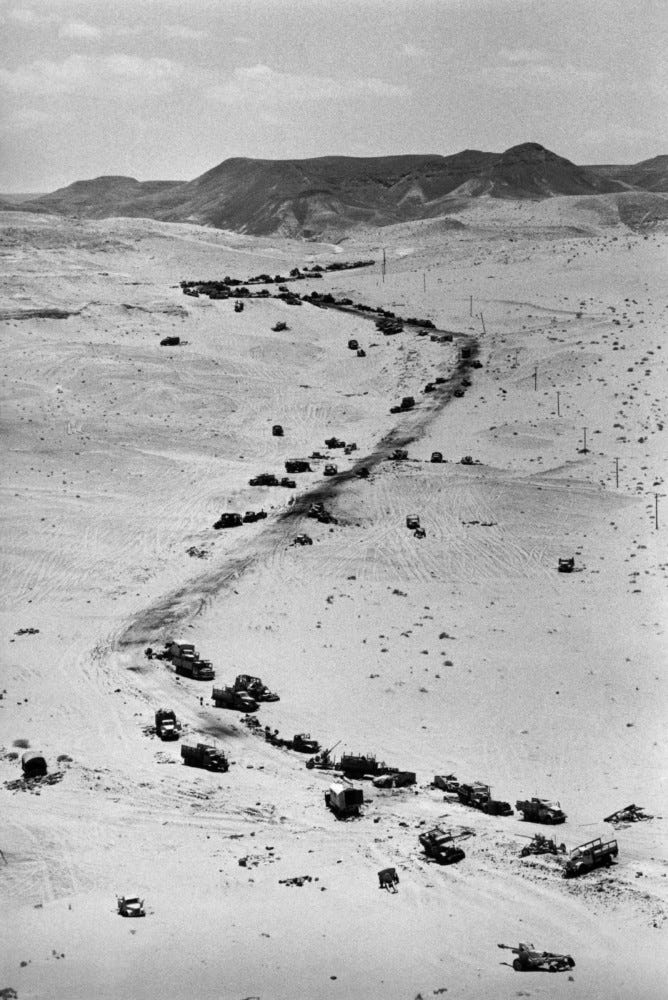
On June 7, after an aerial reconnaissance flight found the area was less defended than originally thought, Israel began its attack on Sharm el-Sheikh. The navy started the operation with a probe of Egyptian naval defenses. At 4:30 am three Israeli torpedo boats opened fire on Egyptian shore batteries, while paratroopers and commandos boarded helicopters and fixed-wing transport aircraft for the assault on Sharm el-Sheikh. They engaged in a pitched battle with Egyptians forces but eventually took the city. At 12:15 pm, Defense Minister Moshe Dayan announced that the Straits of Tiran were, once again, an international waterway open to all ships without restriction. On June 8, Israel completed the capture of the Sinai by sending infantry units to Ras Sudar on the western coast of the peninsula and in a reversal of an earlier policy, Dayan sent IDF units right up to the banks of the Suez Canal.
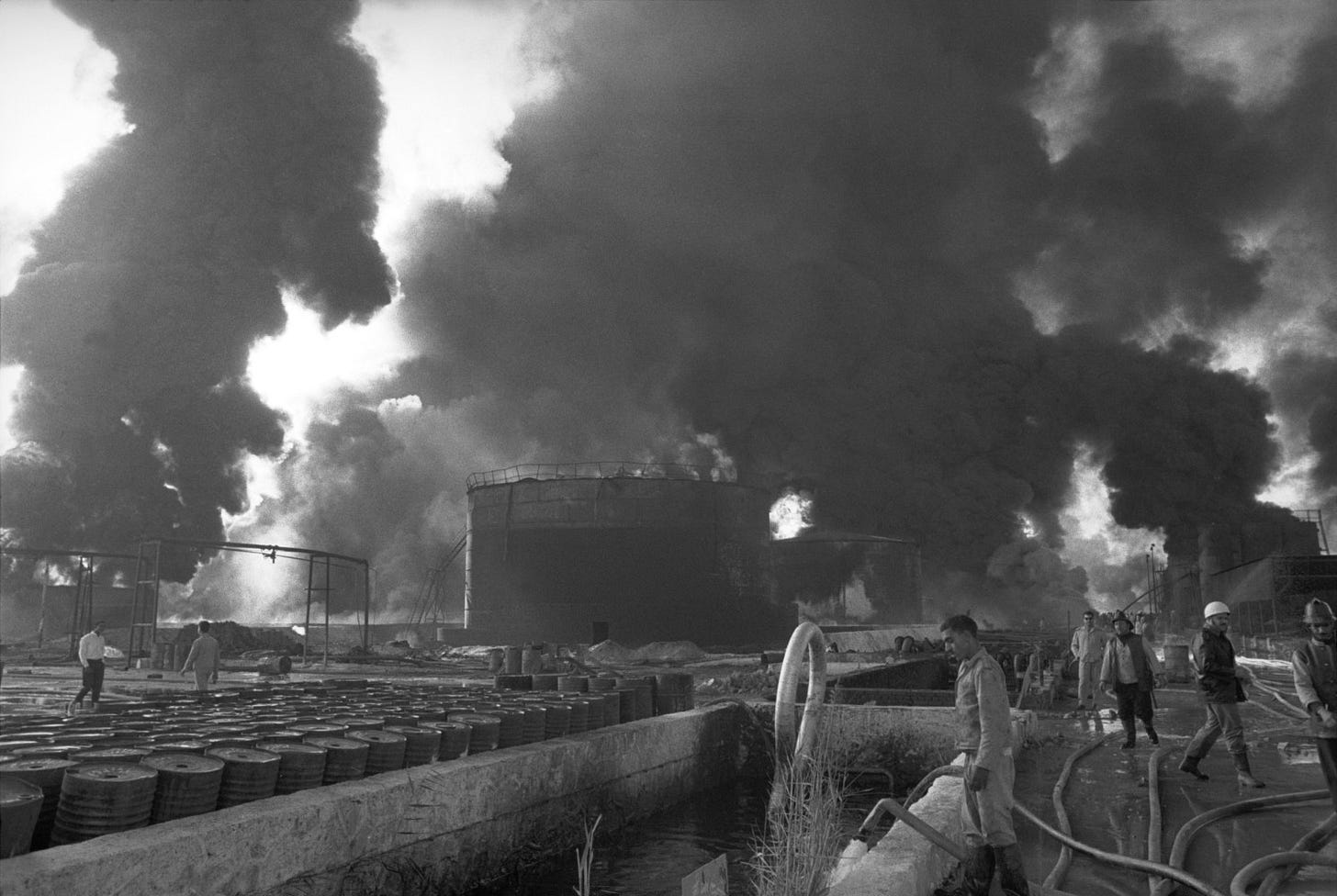
With the exceptions of Rafah and Khan Yunis, Israeli forces had initially avoided entering the Gaza Strip, in fact Moshe Dayan, had expressly forbidden entry into the area. After Palestinian positions in Gaza opened fire on the Negev settlements of Nirim and Kissufim, IDF Chief of Staff Yitzhak Rabin overrode Dayan's instructions and ordered the 11th Mechanized Brigade under Colonel Yehuda Reshef to enter the Strip. The force was immediately met with heavy artillery fire and fierce resistance from Palestinian forces and remnants of the Egyptian forces from Rafah. By sunset, the Israelis had taken the strategically vital Ali Muntar ridge, overlooking Gaza City, but were beaten back from the city itself. On June 6, the 11th Brigade was reinforced by Rafael Eitan and the 202nd Paratroop Brigade, and took Gaza City. The fighting in the entire area was fierce and accounted for nearly half of all Israeli casualties on the southern front. However, with determination Israeli forces took the entire Gaza Strip.
The action now shifted to the Central Front and Jordan. At first the IDF's plan was not to conduct any offensive operations on the Jordanian front, in order to focus on the Sinai campaign. Israel warned King Hussein before the war started that if they did not attack Israel, Israel would not attack Jordan. However, King Hussein wasn’t in a position to make any promises on military actions. Under the defense agreement signed on June 1, he had put Jordan's army under the command of the less than capable General Abdul Munim Riad. On June 5, shortly after the Israeli air attack started, Field Marshal Amer sent a cable to Amman ordering Riad to attack.
Intermittent machine-gun exchanges began taking place in Jerusalem at 9:30 am, and the fighting gradually escalated as the Jordanians introduced heavier weapons. As the intensity of the fire continued to increase, General Uzi Narkis, Commander of Central Command, ordered Israeli forces to respond only with small arms firing in a flat trajectory to avoid hitting any civilians, the holy sites or shooting into the Old City. At 10:00 am the Jordanian Army began shelling the suburbs of Tel Aviv and the Ramat David Airbase. They were ordered to fire a two hour barrage against military and settlements in Central Israel. At 10:30 am, Israeli Prime Minister Levi Eshkol sent a message to King Hussein through Lieutenant General Odd Bull, the Chief of Staff on the United Nations Truce Supervision Organization (UNTSO), promising not to initiate any offensive actions against Jordan if Jordan did not attack them. King Hussein responded that it was too late and the die had been cast. At 11:15 am, Jordanian howitzers began a 6,000-shell barrage targeted at kibbutz Ramat Rachel in the south and Mount Scopus in the north, before shifting to West Jerusalem. Beit Aghion and Beit HaNassi (the Prime Minister’s and President’s residents respectively), the Knesset compound and even the Jerusalem Biblical Zoo, killing 20 civilians and wounding another 1,000. 900 buildings were damaged including the Hadassah Ein Kerem Hospital and it’s stained glass windows made by Marc Chagall. Israel responded to Jordanian shelling with a Luz missile strike that destroyed several Jordanian positions.
At 11:50 am, sixteen Jordanian Hawker Hunters attacked Netanya, Kfar Sirkin and Kfar Saba. Three Iraqi Hawker Hunters strafed civilian settlements in the Jezreel Valley, and an Iraqi Tupolev Tu-16 attacked Afula but was shot down. Sixteen Israeli soldiers were killed, when the Tupolev crashed. Shortly before 12:30 pm, the IAF attacked Jordan's two airbases. The Hawker Hunters were refueling at the time of the attack when Israeli aircraft attacked in two waves, the first wave dropped Matra Durandals destroying the runways and knocked out the control towers. The second wave destroyed all 21 of Jordan's Hawker Hunter fighters, along with six transport aircraft and two helicopters. The Jordanian radar facility at Aijoun was also destroyed. Israeli Fouga Magister jets, normally used as training planes but equipped for combat, attacked the Jordanian 40th Brigade with rockets as it moved south from the Damia Bridge towards Jerusalem. Dozens of tanks were knocked out, and 26 trucks carrying ammunition were destroyed.
Israeli aircraft also attacked H-3, an Iraqi Air Force base in western Iraq. During the attack, twelve MiG-21s, two MiG-17s, Five Hawker Hunters and three Il-28 bombers were destroyed or shot down. Saiful Azam, a Pakistani pilot on loan to the Royal Jordanian Air Force as an advisor, who was stationed at the base at the time of the attack, shot down an Israeli fighter and bomber during the raid.
In the afternoon of the 5th, the Israeli cabinet convened to respond to the Jordanian provocations. Yigal Allon and Menahem Begin argued that they should use this opportunity to take the Old City, home of the Western Wall, the holiest site in Judaism, but Levi Eshkol deferred any decisions until Moshe Dayan and Yitzhak Rabin could be consulted, they were in the Sinai overseeing the attack there. The ranking military man present, Uzi Narkiss, made a number of proposals for military action, including the capture of Latrun, a steppingstone to the Old City, but the cabinet turned him down. Dayan had previously rejected multiple requests from Narkiss for permission to mount an infantry assault towards Mount Scopus as well.
At the same time, a Jordanian battalion advanced up Government House ridge and dug in at the perimeter of Government House (A building in the south corner of Jerusalem, opened in 1930 for the High Commissioners for Palestine during the British Mandate), at that time serving as the headquarters of the United Nations observers. They opened fire on Ramat Rachel, the Allenby Barracks and the Jewish section of Abu Tor with mortars and recoilless rifles. UN observers fiercely protested the incursion into the neutral zone, and several manhandled a Jordanian machine gun out of Government House after the crew had set it up in a second-floor window. After the Jordanians occupied Jabel Mukaber, an advance patrol was sent out and approached Ramat Rachel, where they came under fire from four civilians, including the wife of the kibbutz director, all armed with old Czech-made weapons.
Once the situation had changed, Dayan gave the ok to Narkiss, who launched an offensive to retake Government House and the ridge it stood on (also known, in Biblical times, as the Hill of Evil Council). The Jerusalem Brigade's Reserve Battalion the 161st, under Lieutenant Colonel Asher Dreizin, was given the task. Dreizin had three infantry companies and eight tanks under his command, several of which broke down or became stuck in the mud at Ramat Rachel, leaving only three for the assault. The Jordanians mounted fierce resistance, knocking out two tanks. The Israelis broke through the compound's western gate and began clearing the building with grenades, before General Odd Bull compelled the Israelis to hold their fire, telling them that the Jordanians had already fled. The Israelis proceeded to take Antenna Hill, directly behind Government House, and clear out a series of bunkers to the west and south. The fighting often conducted hand-to-hand, continued for nearly four hours before the surviving Jordanians fell back to trenches but were steadily overwhelmed. During the night, there was intense tank, artillery and mortar fire meant to unnerve the Jordanians. Searchlights were placed on top the Labor Federation building, the tallest in Jerusalem at the time, to further expose and blind them. As this was happening, the Jerusalem Brigade moved to the south side of East Jerusalem and the mechanized Harel Brigade along with the 55th Paratrooper Brigade under Colonel Mordecai Gur completed the encirclement to the north.
On June 6, a combined force of tanks and paratroopers tightened the encirclement by moving near the Mandelbaum Gate. The 66th battalion from Gur's brigade, approached the fortified Police Headquarters, under heavy fire, using Bangalore torpedoes to blast through barbed wire obstacles surrounding the station. After borrowing two tanks from the Jerusalem Brigade, the Headquarters building was finally captured. After a short break when they received reinforcements, they moved up to attack Ammunition Hill. The Jordanian defenders on the Hill were heavily dug-in and resisted the attack with everything they had. The fighting, which was mostly in trenches and bunkers was hand to hand and the most vicious of the entire war. Every officer in the battalion except for two company commanders were killed, forcing sergeants, corporals and even privates to lead the fighting. The 66th Battalion finally captured the position after four hours of heartbreaking fighting. Even after the fighting had ended on Ammunition Hill, Jordanian sniper fire from nearby Givat HaMivtar forced the survivors of the battle to stay in the newly captured trenches, still filled with dead Jordanian soldiers, until the Harel Brigade overran the outpost later in the afternoon.
Later in the afternoon, after replenishing their officer corps and adding other replacements, the 66th battalion drove east, linking up with a small IDF enclave at the Hebrew University on Mount Scopus. Gur's other battalions, the 71st and 28th captured other Jordanian positions around the American Colony, despite being short on men and equipment that were given to the 66th, and having come under a mortar attack while waiting for the signal to advance.
At the same time, the IDF's 4th Brigade occupied the Latrun fortress, which the Jordanians had been driven out of because of heavy Israeli artillery fire. Simultaneously the Harel Brigade attacked Har Ada, to the northwest of Jerusalem. After seven tanks are knocked out by mines, the infantry mounted an assault without armored support. The soldiers advanced under heavy fire, jumping from rock to rock to avoid mines. As the entered the village the fighting became close quarters with knives and bayonets. The Jordanians fell back and Israeli forces advanced through Har Ada and Beit Horon towards Ramallah, taking four fortified villages along the way. By the evening, the brigade arrived in Ramallah. Meanwhile, the 163rd Infantry Battalion secured Abu Tor after a pitched battle, isolating the Old City from Bethlehem and Hebron.
Meanwhile, during the night of the 5th, 600 Egyptian commandos stationed in the West Bank moved to attack Israeli airfields. Led by Jordanian intelligence scouts, they crossed the border and began infiltrating through Israeli settlements towards Ramla and Hatzor. Before they even made it to their target, the commandos were detected and fled into nearby fields to hide. The Israelis set the field ablaze, killing 450 of the doomed commandos, the survivors escaped back to Jordan.
From their base at the American Colony, the paratroopers moved to further isolate the Old City. They planned to approach their objective via the lightly defended Salah al-Din Street. However, they made a wrong turn onto the heavily defended Nablus Road running into fierce resistance. The tanks fired point-blank down the street, while paratroopers mounted repeated charges. Despite repelling multiple Israeli assaults, the Jordanians were forced to give way to the momentum and overwhelming firepower of the Israelis.
Meanwhile, the Israeli 71st Battalion breached barbed wire and minefields and emerged out of Wadi Joz, near the base of Mount Scopus and joined up with the 66th Battalion of Gur’s brigade. From this position the Old City could be cut off from Jericho and East Jerusalem and isolated from Ramallah. When the Israelis spotted a Jordanian counter attack forming on Augusta-Victoria hill along the one remaining route from the West Bank to Jerusalem, they broke up the attack with a massive artillery barrage. An Israeli detachment from Mount Scopus also captured the Rockefeller Museum, just south of Mount Scopus and home to the Dead Sea Scrolls, after a brief firefight.
On June 6, The Harel Brigade, moving south from Tel al-Ful, fought a running battle with thirty Jordanian tanks. The Jordanians stalled the IDF advance and destroyed a number of half-tracks, but the Israelis called in airstrikes which exploited the vulnerability of the external fuel tanks on the Jordanian tanks. The Jordanians lost half their tanks, and retreated towards Jericho, joining up with the Jordanian King Talal Brigade. The Israelis then kept moving south through Shuafat and French Hill and broke through Jordanian defenses at Givat HaMivtar taking Ammunition Hill.
With Jordanian defenses in Jerusalem crumbling, elements of the Jordanian 60th Armored Brigade along with an infantry battalion were sent to reinforce Jerusalem. The original orders were to push the Israelis from the Latrun corridor, but because of the worsening situation in Jerusalem, the brigade was ordered to proceed to Jerusalem's Arab suburbs and attack Mount Scopus. Alongside the armor, were the infantry of the Imam Ali Brigade, as they approaching Issawiya, the force was spotted by Israeli aircraft and decimated by rocket and cannon fire. Other Jordanian attempts to reinforce Jerusalem were beaten back, either by ambushes or airstrikes.
The Egyptian commander of the Jordanian Army General Abdul Munim Riad sent a situation update to Nasser, midday on June 6.
The situation on the West Bank is rapidly deteriorating. A concentrated attack has been launched on every axis, together with heavy fire, day and night. Jordanian, Syrian and Iraqi air forces in position H3 have been virtually destroyed. Upon consultation with King Hussein I have been asked to convey to you the following choices:
1. A political decision to cease fighting to be imposed by a third party (the USA, the Soviet Union or the Security Council).
2. To vacate the West Bank tonight.
3. To go on fighting for one more day, resulting in the isolation and destruction of the entire Jordanian Army.
King Hussein has asked me to refer this matter to you for an immediate reply.
At 10:00 am on June 6, Riad gave an order for Jordanian forces to withdraw across the Jordan River, however that afternoon King Hussein learned of the impending United Nations Security Council Resolution 233 and decided to hold out, in the hope that a ceasefire would be implemented soon. Unfortunately, it was too late, and the counter-order caused confusion and in many cases, it was not possible to regain positions that had already been abandoned.
We are at my self-imposed limit on the length of posts. I try not to go too far over a 25 minute reading time, and right now I’m at 27 minutes. So I’ll end it here, and next week pick it were I left off. I hope you enjoy these posts and maybe you’re even learning something every now and then.

